Peavey CS 4000, CS 4080 User Manual
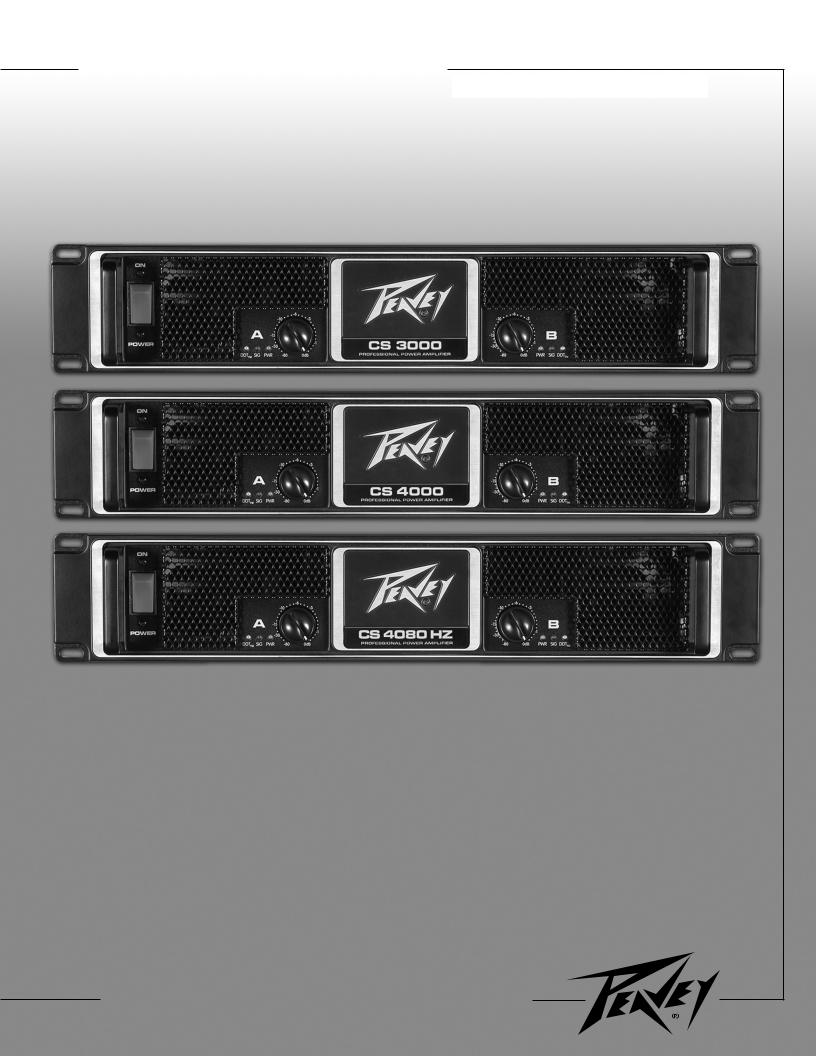
CS® 3000/4000/4080 HZ Power Amplifier Owner's Manual
For more information on other great Peavey products, visit your local Peavey dealer or go online to www.peavey.com
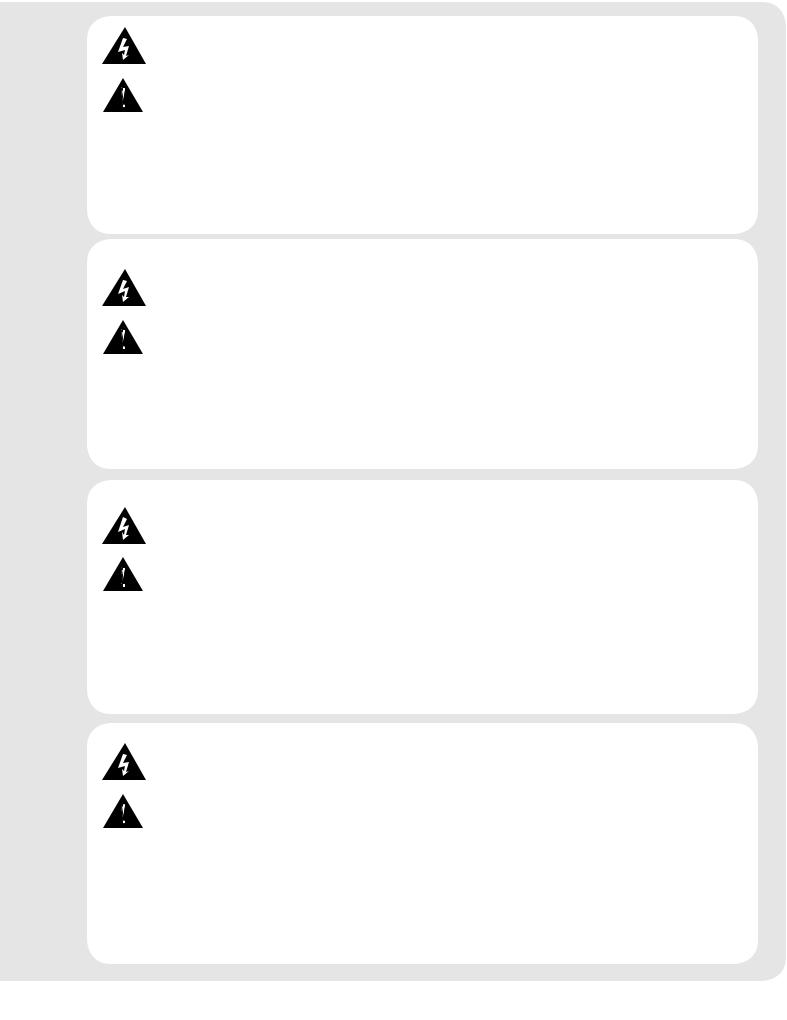
Intended to alert the user to the presence of uninsulated “dangerous voltage” within the product’s enclosure that may be of sufficient magnitude to constitute a risk of electric shock to persons.
Intended to alert the user of the presence of important operating and maintenance (servicing) instructions in the literature accompanying the product.
CAUTION: Risk of electrical shock — DO NOT OPEN!
CAUTION: To reduce the risk of electric shock, do not remove cover. No user serviceable parts inside. Refer servicing to qualified service personnel.
WARNING: To prevent electrical shock or fire hazard, this apparatus should not be exposed to rain or moisture‚ and objects filled with liquids‚ such as vases‚ should not be placed on this apparatus. Before using this apparatus‚ read the operating guide for further warnings.
Este símbolo tiene el propósito, de alertar al usuario de la presencia de “(voltaje) peligroso” sin aislamiento dentro de la caja del producto y que puede tener una magnitud suficiente como para constituir riesgo de descarga eléctrica.
Este símbolo tiene el propósito de alertar al usario de la presencia de instruccones importantes sobre la operación y mantenimiento en la información que viene con el producto.
PRECAUCION: Riesgo de descarga eléctrica ¡NO ABRIR!
PRECAUCION: Para disminuír el riesgo de descarga eléctrica, no abra la cubierta. No hay piezas útiles dentro. Deje todo mantenimiento en manos del personal técnico cualificado.
ADVERTENCIA: Para prevenir choque electrico o riesgo de incendios, este aparato no se debe exponer a la lluvia o a la humedad. Los objetos llenos de liquidos, como los floreros, no se deben colocar encima de este aparato. Antes de usar este aparato, lea la guia de funcionamiento para otras advertencias.
Ce symbole est utilisé dans ce manuel pour indiquer à l’utilisateur la présence d’une tension dangereuse pouvant être d’amplitude suffisante pour constituer un risque de choc électrique.
Ce symbole est utilisé dans ce manuel pour indiquer à l’utilisateur qu’il ou qu’elle trouvera d’importantes instructions concernant l’utilisation et l’entretien de l’appareil dans le paragraphe signalé.
ATTENTION: Risques de choc électrique — NE PAS OUVRIR!
ATTENTION: Afin de réduire le risque de choc électrique, ne pas enlever le couvercle. Il ne se trouve à l’intérieur aucune pièce pouvant être reparée par l’utilisateur. Confiez I’entretien et la réparation de l’appareil à un réparateur Peavey agréé.
AVIS: Dans le but de reduire les risques d’incendie ou de decharge electrique, cet appareil ne doit pas etre expose a la pluie ou a l’humidite et aucun objet rempli de liquide, tel qu’un vase, ne doit etre pose sur celui-ci. Avant d’utiliser de cet appareil, lisez attentivement le guide fonctionnant pour avertissements supplémentaires.
Dieses Symbol soll den Anwender vor unisolierten gefährlichen Spannungen innerhalb des Gehäuses warnen, die von Ausreichender Stärke sind, um einen elektrischen Schlag verursachen zu können.
Dieses Symbol soll den Benutzer auf wichtige Instruktionen in der Bedienungsanleitung aufmerksam machen, die Handhabung und Wartung des Produkts betreffen.
VORSICHT: Risiko — Elektrischer Schlag! Nicht öffnen!
VORSICHT: Um das Risiko eines elektrischen Schlages zu vermeiden, nicht die Abdeckung enfernen. Es befinden sich keine Teile darin, die vom Anwender repariert werden könnten. Reparaturen nur von qualifiziertem Fachpersonal durchführen lassen.
WARNUNG: Um elektrischen Schlag oder Brandgefahr zu verhindern, sollte dieser Apparat nicht Regen oder Feuchtigkeit ausgesetzt werden und Gegenstände mit Flüssigkeiten gefuellt, wie Vasen, nicht auf diesen Apparat gesetzt werden. Bevor dieser Apparat verwendet wird, lesen Sie bitte den Funktionsführer für weitere Warnungen.
2

*.1035"/5 4"'&5: */4536$5*0/4
8"3/*/( 8IFO VTJOH FMFDUSJDBM QSPEVDUT CBTJD DBVUJPOT TIPVME BMXBZT CF GPMMPXFE JODMVEJOH UIF GPMMPXJOH3FBE UIFTF JOTUSVDUJPOT
,FFQ UIFTF JOTUSVDUJPOT)FFE BMM XBSOJOHT
'PMMPX BMM JOTUSVDUJPOT
%P OPU VTF UIJT BQQBSBUVT OFBS XBUFS$MFBO POMZ XJUI B ESZ DMPUI
%P OPU CMPDL BOZ PG UIF WFOUJMBUJPO PQFOJOHT *OTUBMM JO BDDPSEBODF XJUI NBOVGBDUVSFSµT JOTUSVDUJPOT
|
%P OPU JOTUBMM OFBS BOZ IFBU TPVSDFT TVDI BT SBEJBUPST IFBU SFHJTUFST TUPWFT PS PUIFS BQQBSBUVT JODMVEJOH BNQMJGJFST UIBU |
|
QSPEVDF IFBU |
%P OPU EFGFBU UIF TBGFUZ QVSQPTF PG UIF QPMBSJ[FE PS HSPVOEJOH UZQF QMVH " QPMBSJ[FE QMVH IBT UXP CMBEFT XJUI POF XJEFS UIBO UIF PUIFS " HSPVOEJOH UZQF QMVH IBT UXP CMBEFT BOE B UIJSE HSPVOEJOH QMVH 5IF XJEF CMBEF PS UIJSE QSPOH JT QSPWJEFE GPS ZPVS TBGFUZ *G UIF QSPWJEFE QMVH EPFT OPU GJU JOUP ZPVS PVUMFU DPOTVMU BO FMFDUSJDJBO GPS SFQMBDFNFOU PG UIF PCTPMFUF PVUMFU
1SPUFDU UIF QPXFS DPSE GSPN CFJOH XBMLFE PO PS QJODIFE QBSUJDVMBSMZ BU QMVHT DPOWFOJFODF SFDFQUBDMFT BOE UIF QPJOU UIFZ FYJU GSPN UIF BQQBSBUVT
0OMZ VTF BUUBDINFOUT BDDFTTPSJFT QSPWJEFE CZ UIF NBOVGBDUVSFS
6TF POMZ XJUI B DBSU TUBOE USJQPE CSBDLFU PS UBCMF TQFDJGJFE CZ UIF NBOVGBDUVSFS PS TPME XJUI UIF BQQBSBUVT 8IFO B DBSU JT VTFE VTF DBVUJPO XIFO NPWJOH UIF DBSU BQQBSBUVT DPNCJOBUJPO UP BWPJE JOKVSZ GSPN UJQ PWFS
6OQMVH UIJT BQQBSBUVT EVSJOH MJHIUOJOH TUPSNT PS XIFO VOVTFE GPS MPOH QFSJPET PG UJNF
|
3FGFS BMM TFSWJDJOH UP RVBMJGJFE TFSWJDF QFSTPOOFM 4FSWJDJOH JT SFRVJSFE XIFO UIF BQQBSBUVT IBT CFFO EBNBHFE JO BOZ XBZ TVDI |
|
BT XIFO QPXFS TVQQMZ DPSE PS QMVH JT EBNBHFE MJRVJE IBT CFFO TQJMMFE PS PCKFDUT IBWF GBMMFO JOUP UIF BQQBSBUVT UIF BQQBSBUVT |
|
IBT CFFO FYQPTFE UP SBJO PS NPJTUVSF EPFT OPU PQFSBUF OPSNBMMZ PS IBT CFFO ESPQQFE |
/FWFS CSFBL PGG UIF HSPVOE QJO 8SJUF GPS PVS GSFF CPPLMFU ²4IPDL )B[BSE BOE (SPVOEJOH ³ $POOFDU POMZ UP B QPXFS TVQQMZ PG UIF UZQF NBSLFE PO UIF VOJU BEKBDFOU UP UIF QPXFS TVQQMZ DPSE
*G UIJT QSPEVDU JT UP CF NPVOUFE JO BO FRVJQNFOU SBDL SFBS TVQQPSU TIPVME CF QSPWJEFE
/PUF GPS 6, POMZ *G UIF DPMPST PG UIF XJSFT JO UIF NBJOT MFBE PG UIJT VOJU EP OPU DPSSFTQPOE XJUI UIF UFSNJOBMT JO ZPVS QMVHÂ QSPDFFE BT GPMMPXT
B 5IF XJSF UIBU JT DPMPSFE HSFFO BOE ZFMMPX NVTU CF DPOOFDUFE UP UIF UFSNJOBM UIBU JT NBSLFE CZ UIF MFUUFS &Â UIF FBSUI TZNCPMÂ DPMPSFE HSFFO PS DPMPSFE HSFFO BOE ZFMMPX
C 5IF XJSF UIBU JT DPMPSFE CMVF NVTU CF DPOOFDUFE UP UIF UFSNJOBM UIBU JT NBSLFE XJUI UIF MFUUFS / PS UIF DPMPS CMBDL
D 5IF XJSF UIBU JT DPMPSFE CSPXO NVTU CF DPOOFDUFE UP UIF UFSNJOBM UIBU JT NBSLFE XJUI UIF MFUUFS - PS UIF DPMPS SFE
5IJT FMFDUSJDBM BQQBSBUVT TIPVME OPU CF FYQPTFE UP ESJQQJOH PS TQMBTIJOH BOE DBSF TIPVME CF UBLFO OPU UP QMBDF PCKFDUT DPOUBJOJOH MJRVJET TVDI BT WBTFT VQPO UIF BQQBSBUVT
5IF PO PGG TXJUDI JO UIJT VOJU EPFT OPU CSFBL CPUI TJEFT PG UIF QSJNBSZ NBJOT )B[BSEPVT FOFSHZ DBO CF QSFTFOU JOTJEF UIF DIBTTJT XIFO UIF PO PGG TXJUDI JT JO UIF PGG QPTJUJPO 5IF NBJOT QMVH PS BQQMJBODF DPVQMFS JT VTFE BT UIF EJTDPOOFDU EFWJDF UIF EJTDPOOFDU EFWJDF TIBMM SFNBJO SFBEJMZ PQFSBCMF
&YQPTVSF UP FYUSFNFMZ IJHI OPJTF MFWFMT NBZ DBVTF B QFSNBOFOU IFBSJOH MPTT *OEJWJEVBMT WBSZ DPOTJEFSBCMZ JO TVTDFQUJCJMJUZ UP OPJTF JOEVDFE IFBSJOH MPTT CVU OFBSMZ FWFSZPOF XJMM MPTF TPNF IFBSJOH JG FYQPTFE UP TVGGJDJFOUMZ JOUFOTF OPJTF GPS B TVGGJDJFOU UJNF 5IF 6 4 (PWFSONFOUµT 0DDVQBUJPOBM 4BGFUZ BOE )FBMUI "ENJOJTUSBUJPO 04)" IBT TQFDJGJFE UIF GPMMPXJOH QFSNJTTJCMF OPJTF MFWFM FYQPTVSFT
|
|
%VSBUJPO 1FS %BZ *O )PVST |
|
|
|
4PVOE-FWFM E#" 4MPX 3FTQPOTF |
|||
|
|
|
|
|
|
|
|
|
|
|
|||||||||
|
|
|
|
|
|
|
|
|
|
|
|
|
|
|
|
|
|
|
|
|
|
|
|
|
|
|
|
|
|
|
|
|
|
|
|
|
|
|
|
|
|
|
|
|
|
|
|
|
|
|
|
|
|
|
|
|
|
|
|
|
|
|
|
|
|
|
|
|
|
|
|
PS MFTT |
|
|
|
|
|
||
"DDPSEJOH UP 04)" BOZ FYQPTVSF JO FYDFTT PG UIF BCPWF QFSNJTTJCMF MJNJUT DPVME SFTVMU JO TPNF IFBSJOH MPTT &BSQMVHT PS QSPUFDUPST UP UIF FBS DBOBMT PS PWFS UIF FBST NVTU CF XPSO XIFO PQFSBUJOH UIJT BNQMJGJDBUJPO TZTUFN JO PSEFS UP QSFWFOU B QFSNBOFOU IFBSJOH MPTT JG FYQPTVSF JT JO FYDFTT PG UIF MJNJUT BT TFU GPSUI BCPWF 5P FOTVSFBHBJOTU QPUFOUJBMMZ EBOHFSPVT FYQPTVSF UP IJHI TPVOE QSFTTVSF MFWFMT JU JT SFDPNNFOEFE UIBU BMM QFSTPOT FYQPTFE UP FRVJQNFOU DBQBCMF PG QSPEVDJOH IJHI TPVOE QSFTTVSF MFWFMT TVDI BT UIJT BNQMJGJDBUJPO TZTUFN CF QSPUFDUFE CZ IFBSJOH QSPUFDUPST XIJMF UIJT VOJU JT JO PQFSBUJPO
4"7& 5)&4& */4536$5*0/4

8*$)5*(& 4*$)&3)&*54)*/8&*4&
"$)56/( #FJN &JOTBU[ WPO &MFLUSPHFSjUFO N TTFO V B HSVOEMFHFOEF 7PSTJDIUTNB OBINFO CFGPMHU XFSEFO-FTFO 4JF TJDI EJFTF "OXFJTVOHFO EVSDI
#FXBISFO 4JF EJFTF "OXFJTVOHFO BVG#FBDIUFO 4JF BMMF 8BSOVOHFO
#FGPMHFO 4JF BMMF "OXFJTVOHFO
4FU[FO 4JF EJFTFT (FSjU OJDIU JO EFS /jIF WPO 8BTTFS FJO3FJOJHFO 4JF FT OVS NJU FJOFN USPDLFOFO 5VDI
#MPDLJFSFO 4JF LFJOF EFS - GUVOHTzGGOVOHFO ' ISFO 4JF EJF *OTUBMMBUJPO HFNj EFO "OXFJTVOHFO EFT )FSTUFMMFST EVSDI
|
*OTUBMMJFSFO 4JF EBT (FSjU OJDIU OFCFO 8jSNFRVFMMFO XJF )FJ[VOHFO )FJ[HFSjUFO eGFO PEFS BOEFSFO (FSjUFO BVDI 7FSTUjSLFSO EJF |
|
8jSNF FS[FVHFO |
#FFJOUSjDIUJHFO 4JF OJDIU EJF 4JDIFSIFJUTXJSLVOH EFT HFQPMUFO 4UFDLFST C[X EFT &SEVOHTTUFDLFST &JO HFQPMUFS 4UFDLFS XFJTU [XFJ 4UJGUF BVG WPO EFOFO FJOFS CSFJUFS JTU BMT EFS BOEFSF &JO &SEVOHTTUFDLFS XFJTU [XFJ 4UJGUF VOE FJOFO ESJUUFO &SEVOHTTUJGU BVG %FS CSFJUF 4UJGU C[X EFS ESJUUF 4UJGU EJFOU *ISFS 4JDIFSIFJU 4PMMUF EFS CFJMJFHFOEF 4UFDLFS OJDIU JO *ISF 4UFDLEPTF QBTTFO XFOEFO 4JF TJDI CJUUF BO FJOFO &MFLUSJLFS VN EJF VOHFFJHOFUF 4UFDLEPTF BVTUBVTDIFO [V MBTTFO
4DI U[FO 4JF EBT /FU[LBCFM TPEBTT OJFNBOE EBSBVG USJUU PEFS FT HFLOJDLU XJSE JOTCFTPOEFSF BO 4UFDLFSO PEFS #VDITFO VOE JISFO "VTUSJUUTTUFMMFO BVT EFN (FSjU
7FSXFOEFO 4JF OVS EJF WPN )FSTUFMMFS FSIjMUMJDIFO ;VCFIzSHFSjUF PEFS ;VCFIzSUFJMF
7FSXFOEFO 4JF OVS FJOFO 8BHFO 4UBUJW %SFJGV 5SjHFS PEFS 5JTDI EFS EFO "OHBCFO EFT )FSTUFMMFST FOUTQSJDIU PEFS [VTBNNFO NJU EFN (FSjU WFSLBVGU XVSEF 8JSE FJO 8BHFO WFSXFOEFU CFXFHFO 4JF EFO 8BHFO NJU EFN EBSBVG CFGJOEMJDIFO (FSjU CFTPOEFST  WPSTJDIUJH EBNJU FS OJDIU VNLJQQU VOE NzHMJDIFSXFJTF KFNBOE WFSMFU[U XJSE
WPSTJDIUJH EBNJU FS OJDIU VNLJQQU VOE NzHMJDIFSXFJTF KFNBOE WFSMFU[U XJSE
|
5SFOOFO 4JF EBT (FSjU XjISFOE FJOFT (FXJUUFST PEFS XjISFOE MjOHFSFS ;FJUSjVNF JO EFOFO FT OJDIU CFOVU[U XJSE WPO EFS |
|
4USPNWFSTPSHVOH |
-BTTFO 4JF TjNUMJDIF 8BSUVOHTBSCFJUFO WPO RVBMJGJ[JFSUFO ,VOEFOEJFOTUUFDIOJLFSO EVSDIG ISFO &JOF 8BSUVOH JTU FSGPSEFSMJDI XFOO EBT (FSjU JO JSHFOEFJOFS "SU CFTDIjEJHU XVSEF FUXB XFOO EBT /FU[LBCFM PEFS EFS /FU[TUFDLFS CFTDIjEJHU XVSEFO 'M TTJHLFJU PEFS (FHFOTUjOEF JO EBT (FSjU HFMBOHU TJOE EBT (FSjU 3FHFO PEFS 'FVDIUJHLFJU BVTHFTFU[U XVSEF OJDIU OPSNBM BSCFJUFU PEFS IFSVOUFSHFGBMMFO JTU
%FS &SEVOHTTUJGU EBSG OJF FOUGFSOU XFSEFO "VG 8VOTDI TFOEFO XJS *IOFO HFSOF VOTFSF LPTUFOMPTF #SPTDI SF Ã4IPDL )B[BSE BOE (SPVOEJOH² (FGBIS EVSDI FMFLUSJTDIFO 4DIMBH VOE &SEVOH [V 4DIMJF FO 4JF OVS BO EJF 4USPNWFSTPSHVOH EFS "SU BO EJF BN (FSjU OFCFO EFN /FU[LBCFM BOHFHFCFO JTU
8FOO EJFTFT 1SPEVLU JO FJO (FSjUF 3BDL FJOHFCBVU XFSEFO TPMM NVTT FJOF 7FSTPSHVOH CFS EJF 3 DLTFJUF FJOHFSJDIUFU XFSEFO
)JOXFJT ° /VS G S (SP CSJUBOOJFO 4PMMUF EJF 'BSCF EFS %SjIUF JO EFS /FU[MFJUVOH EJFTFT (FSjUT OJDIU NJU EFO ,MFNNFO JO *ISFN 4UFDLFSCFSFJOTUJNNFO HFIFO 4JF GPMHFOEFSNB FO WPS
B %FS HS O HFMCF %SBIU NVTT BO EJF NJU & 4ZNCPM G S &SEF NBSLJFSUF C[X HS OF PEFS HS O HFMCF ,MFNNF BOHFTDIMPTTFO XFSEFO
C %FS CMBVF %SBIU NVTT BO EJF NJU / NBSLJFSUF C[X TDIXBS[F ,MFNNF BOHFTDIMPTTFO XFSEFO
D %FS CSBVOF %SBIU NVTT BO EJF NJU - NBSLJFSUF C[X SPUF ,MFNNF BOHFTDIMPTTFO XFSEFO
%JFTFT (FSjU EBSG OJDIU VOHFTDI U[U 8BTTFSUSPQGFO VOE 8BTTFSTQSJU[FSO BVTHFTFU[U XFSEFO VOE FT NVTT EBSBVG HFBDIUFU XFSEFO EBTT LFJOF NJU 'M TTJHLFJUFO HFG MMUF (FHFOTUjOEF XJF [ # #MVNFOWBTFO BVG EFN (FSjU BCHFTUFMMU XFSEFO
%FS /FU[TDIBMUFS JO EJFTFS &JOIFJU CSJDIU CFJEF 4FJUFO WPO EFO QSJNjSFO )BVQMFJUVOHFO OJDIU (FSGjISMJDIF &OFSHJF LBOO BOXFTFOE JOOFSIBMC EFT $IBTTJT TFJO XFOO IFS /FU[TDIBMUFS JN BC 1PTJUJPO JTU %JF )BVQUMFJUVOHFO TUzQTFMO [V PEFS (FSjULVQQMVOH JTU CFOVU[U XjISFOE EBT 7PSSJDIUVOH BCTDIBMUFU EBT TDIBMUFU 7PSSJDIUVOH XJSE CMFJCFO TPHMFJDI IBOUJFSCBS BC
#FMBTUVOH EVSDI FYUSFN IPIF -jSNQFHFM LBOO [V EBVFSIBGUFN (FIzSWFSMVTU G ISFO %JF "OGjMMJHLFJU G S EVSDI -jSN CFEJOHUFO (FIzSWFSMVTU JTU WPO .FOTDI [V .FOTDI WFSTDIJFEFO EBT (FIzS XJSE KFEPDI CFJ KFEFN JO HFXJTTFN .B F HFTDIjEJHU EFS CFS FJOFO CFTUJNNUFO ;FJUSBVN BVTSFJDIFOE TUBSLFN -jSN BVTHFTFU[U JTU %JF 64 "SCFJUTTDIVU[CFIzSEF 0DDVQBUJPOBM BOE )FBMUI "ENJOJTUSBUJPO 04)" IBU EJF GPMHFOEFO [VMjTTJHFO 1FHFM G S -jSNCFMBTUVOH GFTUHFMFHU
|
|
%BVFS QSP 5BH JO 4UVOEFO |
(FSjVTDIQFHFM E#" MBOHTBNF 3FBLUJPO |
|
|
|
|
|
|
|
|
|
|
|
|
|
|
|
|
|
|
|
|
|
|
|
|
|
|
|
|
|
|
|
|
|
|
PEFS XFOJHFS |
|
-BVU 04)" LBOO KFEF #FMBTUVOH CFS EFO PCFOTUFIFOEFO [VMjTTJHFO (SFO[XFSUFO [V FJOFN HFXJTTFO (FIzSWFSMVTU G ISFO 4PMMUF EJF #FMBTUVOH EJF PCFOTUFIFOEFO (SFO[XFSUF CFSTUFJHFO N TTFO CFJN #FUSJFC EJFTFT 7FSTUjSLVOHTTZTUFNT 0ISFOTUPQGFO PEFS 4DIVU[WPSSJDIUVOHFO JN (FIzSHBOH PEFS CFS EFO 0ISFO HFUSBHFO XFSEFO VN FJOFO EBVFSIBGUFO (FIzSWFSMVTU [V WFSIJOEFSO 6N TJDI WPS FJOFS NzHMJDIFSXFJTF HFGjISMJDIFO #FMBTUVOH EVSDI IPIF 4DIBMMESVDLQFHFM [V TDI U[FO XJSE BMMFO 1FSTPOFO FNQGPIMFO EJF NJU (FSjUFO BSCFJUFO EJF XJF EJFTFT 7FSTUjSLVOHTTZTUFN IPIF 4DIBMMESVDLQFHFM FS[FVHFO LzOOFO CFJN #FUSJFC EJFTFT (FSjUT FJOFO (FIzSTDIVU[ [V USB HFO
#&8")3&/ 4*& %*&4& 4*$)&3)&*54)*/8&*4& "6'
4

|
*/4536$5*0/4 *.1035"/5&4 %& 4&$63*5& |
"55&/5*0/ -µVUJMJTBUJPO EF UPVU BQQBSFJM nMFDUSJRVF EPJU pUSF TPVNJTF BVY QSFDBVUJPOT EµVTBHF JODMVBOU |
|
|
-JSF DFT JOTUSVDUJPOT |
|
(BSEF[ DF NBOVFM QPVS EF GVUVSFT SnGnSFODFT |
|
1SnUF[ BUUFOUJPO BVY NFTTBHFT EF QSnDBVUJPOT EF DF NBOVFM |
|
4VJWF[ DFT JOTUSVDUJPOT |
|
/µVUJMJTF[ QBT DFUUF VOJUn QSPDIF EF QMBOT EµFBV |
|
/µVUJMJTF[ RVµVO UJTTV TFD QPVS MF OFUUPZBHF EF WPUSF VOJUn |
|
/µPCTUSVF[ QBT MFT TZTUoNFT EF SFGSPJEJTTFNFOU EF WPUSF VOJUn FU JOTUBMMF[ WPUSF VOJUn FO GPODUJPO EFT JOTUSVDUJPOT EF DF |
|
NBOVFM |
|
/F QPTJUJPOOF[ QBT WPUSF VOJUn h QSPYJNJUn EF UPVUF TPVSDF EF DIBMFVS |
|
$POOFDUF[ UPVKPVST WPUSF VOJUn TVS VOF BMJNFOUBUJPO NVOJF EF QSJTF EF UFSSF VUJMJTBOU MF DPSEPO EµBMJNFOUBUJPO GPVSOJ |
|
1SPUnHF[ MFT DPOOFDUFVST EF WPUSF VOJUn FU QPTJUJPOOF[ MFT DBCMBHFT QPVS nWJUFS UPVUFT EnDPOOFYJPOT BDDJEFOUFMMFT |
|
/µVUJMJTF[ RVF EFT GJYBUJPOT BQQSPVWnFT QBS MF GBCSJRVBOU |
|
-PST EF MµVUJMTBUJPO TVS QJFE PV QPMF EF TVQQPSU BTTVSF[ EBOT MF DBT EF EnQMBDFNFOU EF MµFOTFNCMF FODFJOUF TVQQPSU EF |
|
QSnWFOJS UPVU CBTDVMFNFOU JOUFNQFTUJG EF DFMVJ DJ |
|
*M FTU DPOTFJMMn EF EnDPOOFDUFS EV TFDUFVS WPUSF VOJUn FO DBT EµPSBHF PV EF EVSnF QSPMPOHnF TBOT VUJMJTBUJPO |
|
4FVM VO UFDIOJDJFO BHSnn QBS MF GBCSJRVBOU FTU h NpNF EF SnQBSFS DPOUSyMFS WPUSF VOJUn $FMMF DJ EPJU pUSF DPOUSyMnF TJ FMMF |
|
B TVCJU EFT EPNNBHFT EF NBOJQVMBUJPO EµVUJMJTBUJPO PV EF TUPDLBHF IVNJEJUn © |
|
/F EnDPOOFDUF[ KBNBJT MB QSJTF EF UFSSF EF WPUSF VOJUn |
|
4J WPUSF VOJUn FTU EFTUJOnF B FUSF NPOUnF FO SBDL EFT TVQQPSUT BSSJFSF EPJWFOU FUSF VUJMJTFT |
|
/PUF QPVS MFT 3PZBVNFT 6OJT 4J MFT DPVMFVST EF DPOOFDUFVST EV DBCMF EµBMJNFOUBUJPO OF DPSSFTQPOE QBT BV HVJEF EF MB |
|
QSJTF TFDUFVS QSPDnEF[ DPNNF TVJU |
|
B -F DPOOFDUFVS WFSU FU KBVOF EPJU pUSF DPOOFDUSFS BV UFSNJOBM OPUn & JOEJRVBOU MB QSJTF EF UFSSF PV DPSSFTQPOEBOU BVY |
|
DPVMFVST WFSUF PV WFSUF FU KBVOF EV HVJEF |
|
C -F DPOOFDUFVS #MFV EPJU pUSF DPOOFDUSFS BV UFSNJOBM OPUn / DPSSFTQPOEOBU h MB DPVMFVS OPJSF EV HVJEF |
|
D -F DPOOFDUFVS NBSSPO EPJU pUSF DPOOFDUSFS BV UFSNJOBM OPUn - DPSSFTQPOEBOU h MB DPVMFVS SPVHF EV HVJEF |
|
$FU nRVJQFNFOU nMFDUSJRVF OF EPJU FO BVDVO DBT pUSF FO DPOUBDU BWFD VO RVFMDPORVF MJRVJEF FU BVDVO PCKFU DPOUFOBOU VO |
|
MJRVJEF WBTF PV BVUSF OF EFWSBJU pUSF QPTn TVS DFMVJ DJ |
|
- JOUFSSVQUFS PO PGG EBOT DFUUF VOJUo OF DBTTF QBT MFT EFVY DyUoT EV QSJNBJSF QSJODJQBM - nOFSHJF IBTBSEFVTF QFVU |
|
pUSF QSFnTFOUF EBOT MF DIiTTJT RVBOE M JOUFSSVQUFS PO PGG FTU EBOT MF EF MB QPTJUJPO -F CPVDIPO QSJODJQBM PV BUFMBHF |
|
E BQQBSFJM FTU VUJMJTn DPNNF MF EnCSBODIFS M BQQBSFJM SFTUFSB GBDJMFNFOU PQnSBCMF |
|
6OF FYQPTJUJPO h EF IBVUT OJWFBVY TPOPSFT QFVU DPOEVJSF h EFT EPNNBHFT EF MµnDPVUF JSSnWFSTJCMFT -B TVTDFQUJCJMJUn |
|
BV CSVJU WBSJF DPOTJEnSBCMFNFOU EµVO JOEJWJEV h MµBVUSF NBJT VOF MBSHF NBKPSJUn EF MB QPQVMBUJPO FYQnSJFODFSB VOF |
|
QFSUF EF MµnDPVUF BQSoT VOF FYQPTJUJPO h VOF GPSUF QVJTTBODF TPOPSF QPVS VOF EVSnF QSPMPOHnF -µPSHBOJTNF EF MB TBOUn |
|
BNnSJDBJOF 04)" B QSPEVJU MF HVJEF DJ EFTTPVT FO SBQQPSU h MB QFSUF PDDBTJPOOnF |
|
|
%VSnF QBS +PVS IFVSFT |
/JWFBV TPOPSF NPZFO E#" |
|
|
|
|
|
|
|
|
|
|
|
|
|
|
|
|
|
|
|
|
|
|
|
|
|
|
|
|
|
|
|
|
|
|
PV JOGnSJFVS |
|
%µBQSoT MFT nUVEFT NFOnFT QBS MF 04)" UPVUF FYQPTJUJPO BV EFMh EFT MJNJUFT EnDSJUFT DF EFTTVT FOUSBJOFSB EFT QFSUFT EF MµnDPVUF DIF[ MB QMVQBSU EFT TVKFUT -F QPSU EF TZTUoNF EF QSPUFDUJPO DBTRVF PSFJMFUUF EF GJMUSBHF © EPJU pUSF PCTFSWn MPST EF MµPQnSBUJPO DFUUF VOJUn PV EFT EPNNBHFT JSSnWFSTJCMFT QFVWFOU pUSF PDDBTJPOOnT -F QPSU EF DFT TZTUoNFT EPJU pUSF PCTFSWn QBS UPVUFT QFSTPOOFT TVTDFQUJCMFT EµpUSF FYQP TnFT h EFT DPOEJUJPOT BV EFMh EFT MJNJUFT EnDSJUFT DJ EFTTVT
("3%&; $&4 */4536$5*0/4
5

*/4536$$*0/&4 *.1035"/5&4 1"3" 46 4&(63*%"%
$6*%"%0 $VBOEP VTF QSPEVDUPT FMFDUSwOJDPT EFCF UPNBS QSFDBVDJPOFT CgTJDBT JODMVZFOEP MBT TJHVJFOUFT
-FB FTUBT JOTUSVDDJPOFT
|
(VBSEF FTUBT JOTUSVDDJPOFT |
|
)BHB DBTP EF UPEPT MPT DPOTFKPT |
|
4JHB UPEBT MBT JOTUSVDDJPOFT |
|
/P VTBS FTUF BQBSBUP DFSDB EFM BHVB |
|
-JNQJBS TPMBNFOUF DPO VOB UFMB TFDB |
|
/P CMPRVFBS OJOHVOB EF MBT TBMJEBT EF WFOUJMBDJwO *OTUBMBS EF BDVFSEP B MBT JOTUSVDDJPOFT EFM GBCSJDBOUF |
|
/P JOTUBMBS DFSDB EF OJOHVOB GVFOUF EF DBMPS DPNP SBEJBEPSFT FTUVGBT IPSOPT V PUSPT BQBSBUPT JODMVZFOEP BNQMJGJDBEPSFT RVF |
|
QSPEV[DBO DBMPS |
|
/P SFUJSF MB QBUJMMB QSPUFDUPSB EFM FODIVGF QPMBSJ[BEP P EF UJQP ²B 5JFSSB³ 6O FODIVGF QPMBSJ[BEP UJFOF EPT QVOUBT VOB EF FMMBT NgT |
|
BODIB RVF MB PUSB 6O FODIVGF EF UJQP ²B 5JFSSB³ UJFOF EPT QVOUBT Z VOB UFSDFSB ²B 5JFSSB³ -B QVOUB BODIB MB UFSDFSB TF QSPQPSDJPOB |
|
QBSB TV TFHVSJEBE 4J FM FODIVGF QSPQPSDJPOBEP OP FODBKB FO TV FODIVGF EF SFE DPOTVMUF B VO FMFDUSJDJTUB QBSB RVF SFFNQMB[F TV |
|
FODIVGF PCTPMFUP |
|
1SPUFKB FM DBCMF EF BMJNFOUBDJwO QBSB RVF OP TFB QJTBEP P QJODIBEP QBSUJDVMBSNFOUF FO MPT FODIVGFT IVFDPT Z MPT QVOUPT RVF TBMFO |
|
EFM BQBSBUP |
|
6TBS TPMBNFOUF BvBEJEPT BDDFTPSJPT QSPQPSDJPOBEPT QPS FM GBCSJDBOUF |
|
6TBS TPMBNFOUF VO DBSSP QJF USrQPEF P TPQPSUF FTQFDJGJDBEP QPS FM GBCSJDBOUF P WFOEJEP KVOUP BM BQBSBUP $VBOEP TF VTF VO DBSSP |
|
UFOHB DVJEBEP BM NPWFS FM DPOKVOUP DBSSP BQBSBUP QBSB FWJUBS RVF TF EBvF FO VO WVFMDP /P TVTQFOEB FTUB DBKB EF OJOHVOB NBOFSB |
|
%FTFODIVGF FTUF BQBSBUP EVSBOUF UPSNFOUBT P DVBOEP OP TFB VTBEP EVSBOUF MBSHPT QFSJPEPT EF UJFNQP |
|
1BSB DVBMRVJFS SFQBSBDJwO BDVEB B QFSTPOBM EF TFSWJDJP DVBMJGJDBEP 4F SFRVJFSFO SFQBSBDJPOFT DVBOEP FM BQBSBUP IB TJEP EBvBEP EF |
|
BMHVOB NBOFSB DPNP DVBOEP FM DBCMF EF BMJNFOUBDJwO P FM FODIVGF TF IBO EBvBEP BMH|O MrRVJEP IB TJEP EFSSBNBEP P BMH|O PCKFUP IB |
|
DBrEP EFOUSP EFM BQBSBUP FM BQBSBUP IB TJEP FYQVFTUP B MB MMVWJB P MB IVNFEBE OP GVODJPOB EF NBOFSB OPSNBM P IB TVGSJEP VOB DBrEB |
|
/VODB SFUJSF MB QBUJMMB EF 5JFSSB &TDSrCBOPT QBSB PCUFOFS OVFTUSP GPMMFUP HSBUVJUP ²4IPDL )B[BSE BOE (SPVOEJOH³ ²1FMJHSP EF |
|
&MFDUSPDVDJwO Z 5PNB B 5JFSSB³ $POFDUF FM BQBSBUP TwMP B VOB GVFOUF EF BMJNFOUBDJwO EFM UJQP NBSDBEP BM MBEP EFM DBCMF EF |
|
BMJNFOUBDJwO |
4J FTUF QSPEVDUP WB B TFS FOSBDBEP DPO NgT FRVJQP VTF BMH|O UJQP EF BQPZP USBTFSP
/PUB QBSB FM 3FJOP 6OJEP TPMBNFOUF 4J MPT DPMPSFT EF MPT DBCMFT FO FM FODIVGF QSJODJQBM EF FTUB VOJEBE OP DPSSFTQPOEFO DPO MPT UFSNJOBMFT FO TV FODIVGFÂ QSPDFEB EF MB TJHVJFOUF NBOFSB
B &M DBCMF EF DPMPS WFSEF Z B[VM EFCF TFS DPOFDUBEP BM UFSNJOBM RVF FTUg NBSDBEP DPO MB MFUSB &Â FM TrNCPMP EF 5JFSSB FBSUI Â DPMPSFBEP FO WFSEF P FO WFSEF Z BNBSJMMP
C &M DBCMF DPMPSFBEP FO B[VM EFCF TFS DPOFDUBEP BM UFSNJOBM RVF FTUg NBSDBEP DPO MB MFUSB / P FM DPMPS OFHSP
D &M DBCMF DPMPSFBEP FO NBSSwO EFCF TFS DPOFDUBEP BM UFSNJOBM RVF FTUg NBSDBEP DPO MB MFUSB - P FM DPMPS SPKP
&TUF BQBSBUP FMnDUSJDP OP EFCF TFS TPNFUJEP B OJOH|O UJQP EF HPUFP P TBMQJDBEVSB Z TF EFCF UFOFS DVJEBEP QBSB OP QPOFS PCKFUPT RVF DPOUFOHBO MrRVJEPT DPNP WBTPT TPCSF FM BQBSBUP
&M JOUFSSVQUPS EF FO MFKPT FO FTUB VOJEBE OP SPNQF BNCPT MBEPT EF MB SFE QSJNBSJB -B FOFSHrB QFMJHSPTB QVFEF TFS QSFTFOUF EFOUSP EFM DIBTJT DVBOEP FM JOUFSSVQUPS EF FO MFKPT FTUg FO FM EF MB QPTJDJwO &M UBQwO EF MB SFE P FM BDPQMBEPS EFM BQBSBUP TPO VUJMJ[BEPT DPNP FM EFTDPOFDUB EJTQPTJUJWP FM EFTDPOFDUB EJTQPTJUJWP TF RVFEBSg GgDJMNFOUF PQFSBCMF
-B FYQPTJDJwO B BMUPT OJWFMFT EF SVJEP QVFEF DBVTBS VOB QnSEJEB QFSNBOFOUF FO MB BVEJDJwO -B TVTDFQUJCJMJEBE B MB QnSEJEB EF BVEJDJwO QSPWPDBEB QPS FM SVJEP WBSrB TFH|O MB QFSTPOB QFSP DBTJ UPEP FM NVOEP QFSEFSg BMHP EF BVEJDJwO TJ TF FYQPOF B VO OJWFM EF SVJEP TVGJDJFOUFNBOUF JOUFOTP EVSBOUF VO UJFNQP EFUFSNJOBEP &M %FQBSUBNFOUP QBSB MB 4BMVE Z QBSB MB 4FHVSJEBE EFM (PCJFSOP EF MPT &TUBEPT 6OJEPT 04)" IB FTQFDJGJDBEP MBT TJHVJFOUFT FYQPTJDJPOFT BM SVJEP QFSNJTJCMFT
|
|
|
%VSBDJwO QPS %rB FO )PSBT /JWFM EF 4POJEP E#" 3FTQVFTUB-FOUB |
|
|
|
|
|
|
|
|
|
|
|
|
|
|
|
|
|
|
|
|
|
|
|
|
|
|
|
|
|
|
|
|
|
|
|
|
|
|
|
|
|
|
|
|
P NFOPT |
|
%F BDVFSEP BM 04)" DVBMRVJFS FYQPTJDJwO RVF FYDFEB MPT MrNJUFT BSSJCB JOEJDBEPT QVFEF QSPEVDJS BMH|O UJQP EF QnSEJEB FO MB BVEJDJwO 1SPUFDUPSFT QBSB MPT DBOBMFT BVEJUJWPT P UBQPOFT QBSB MPT PrEPT EFCFO TFS VTBEPT DVBOEP TF PQFSF DPO FTUF TJTUFNB EF TPOJEP QBSB QSFWF OJS VOB QnSEJEB QFSNBOFOUF FO MB BVEJDJwO TJ MB FYQPTJDJwO FYDFEF MPT MrNJUFT JOEJDBEPT NgT BSSJCB 1BSB QSPUFHFSTF EF VOB FYQPTJDJwO B BMUPT OJWFMFT EF TPOJEP QPUFODJBMNFOUF QFMJHSPTB TF SFDPNJFOEB RVF UPEBT MBT QFSTPOBT FYQVFTUBT B FRVJQBNJFOUP DBQB[ EF QSPEVDJS BMUPT OJWFMFT EF QSFTJwO TPOPSB UBMFT DPNP FTUF TJTUFNB EF BNQMJGJDBDJwO TF FODVFOUSFO QSPUFHJEBT QPS QSPUFDUPSFT BVEJUJWPT NJFOUSBT FTUB VOJ EBE FTUn PQFSBOEP
(6"3%& &45"4 */4536$$*0/&4
6

ENGLISH
CS® 3000/4000/4080 HZ
Power Amplifiers
Congratulations on your purchase of a Peavey CS Series power amplifier! Designed for years of reliable operation, CS Series amplifiers offer the sonic superiority and unsurpassed reliability for which Peavey is famous in a rugged, compact unit. Advanced technologies and extensive protection circuitry allow operation with greater efficiency, even under difficult loads and power conditions. The DDT™ (Distortion Detection Technique) circuit ensures trouble-free operation into loads as low as 2 ohms (4 ohms for model CS 4080 HZ), protects speakers and ensures, protects drivers and ensures sonic integrity even in extreme overload conditions. Peavey’s high-efficiency design uses tunnel-cooled heat sinks and dual-speed DC fans for consistent lower overall operating temperature, resulting in longer output transistor life.
Peavey CS Series amplifiers are simple to operate and housed in ultra-strong steel chassis, but improper use can be dangerous. Some CS Series amplifiers are very high powered and can put out high voltages and sizable currents at frequencies up to 30 kHz. Always use safe operating techniques with these amplifiers.
FOR YOUR SAFETY, READ THE IMPORTANT PRECAUTIONS SECTION, AS WELL AS INPUT, OUTPUT AND POWER CONNECTION SECTIONS.
Unpacking
Upon unpacking, inspect the amplifier. If you find any damage, notify your supplier immediately. Only the consignee (the supplier from whom you purchased the amplifier) may institute a claim with the carrier for damage incurred during shipping. Be sure to save the carton and all packing materials. Should you ever need to ship the unit back to Peavey or one of its offices, service centers or the supplier, use only the original factory packing. If the shipping carton is unavailable, contact Peavey to obtain a replacement.
Mounting
CS Series amplifiers will mount in standard 19" racks. Rear mounting ears are also provided for additional support, which is recommended in non-permanent installations like mobile or touring sound systems. Because of the cables and connectors on the rear panel, a right angle or offset screwdriver or hex key will make it easier to fasten the rear mounting ears to the rails.
Cooling Requirements
CS Series amplifiers use a forced-air cooling system to maintain a low, consistent operating temperature. Air is drawn into the amplifier by fans on the back panel and courses through the cooling fins of the tunnel-configured channel heat sinks, then exhausts through the front panel grilles. If either heat sink gets too hot, a sensing circuit will disconnect the load for that particular channel. It is important to have an air inlet at the back of the amplifier to allow cooling air to enter. If the amp is rack mounted, do not use doors or covers on the back of the rack, as the intake air must flow without resistance. Make sure that there is one (1) standard rack space opening for every three mounted power amplifiers.
7
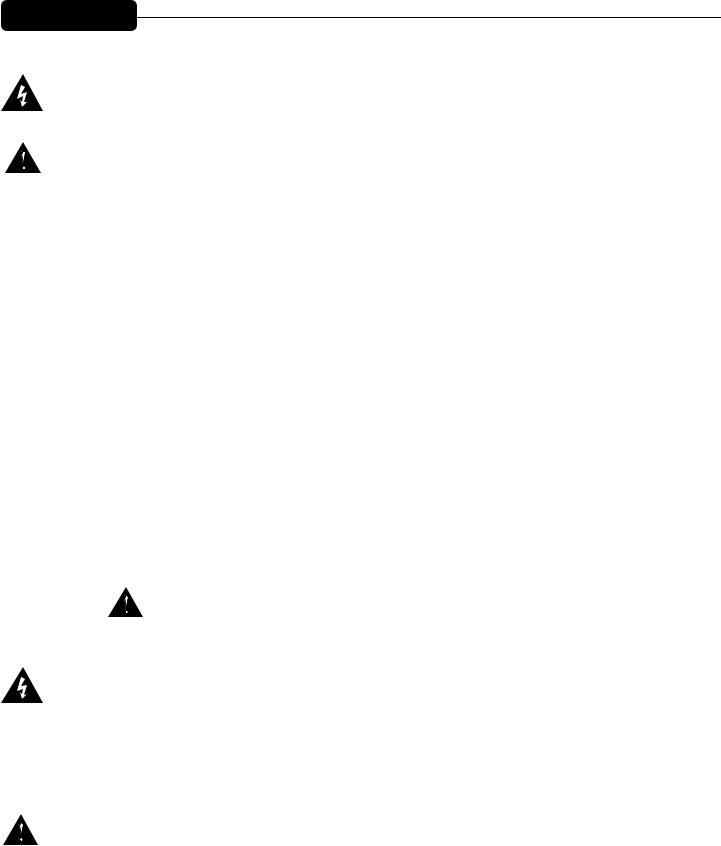
*OUSPEVDUJPO
0QFSBUJOH 1SFDBVUJPOT
.BLF TVSF UIF NBJOT WPMUBHF JT DPSSFDU BOE JT UIF TBNF BT UIBU QSJOUFE PO UIF SFBS PG UIF BNQMJGJFS %BNBHF DBVTFE CZ DPOOFDUJOH UIF BNQMJGJFS UP JNQSPQFS "$ WPMUBHF JT OPU DPWFSFE CZ BOZ $4 4FSJFT XBSSBOUZ 4FF UIF $POOFDUJOH 1PXFS TFDUJPO GPS NPSF JOGPSNBUJPO PO WPMUBHF SFRVJSFNFOUT
/PUF "MXBZT UVSO PGG BOE EJTDPOOFDU UIF BNQMJGJFS GSPN NBJOT WPMUBHF CFGPSF NBLJOH BVEJP DPOOFDUJPOT "MTP BT BO FYUSB QSFDBVUJPO IBWF UIF BUUFOVBUPST UVSOFE EPXO EVSJOH QPXFS VQ
"MUIPVHI UIF $4 ); BNQMJGJFST IBWF 3BNQ6Q DJSDVJUSZ XIJDI SBJTFT UIF TJHOBM MFWFM HSBEVBMMZ BGUFS UIF PVUQVU SFMBZ DMPTFT JU JT BMXBZT B HPPE JEFB UP IBWF UIF HBJO DPOUSPMT UVSOFE EPXO EVSJOH QPXFS VQ UP QSFWFOU TQFBLFS EBNBHF JG UIFSF JT B IJHI TJHOBM MFWFM BU UIF JOQVUT "MXBZT VTF IJHI RVBMJUZ JOQVU BOE TQFBLFS DBCMFT UP FOTVSF USPVCMF GSFF PQFSBUJPO .PTU JOUFSNJUUFOU QSPCMFNT BSF DBVTFE CZ GBVMUZ DBCMFT
$POTVMU UIF 8JSF (BVHF $IBSUT QBHF UP EFUFSNJOF QSPQFS HBVHFT GPS EJGGFSJOH MPBE JNQFEBODFT BOE DBCMF MFOHUIT $BCMF SFTJTUBODF SPCT BNQMJGJFS QPXFS JO UXP XBZT QPXFS MPTU EJSFDUMZ UP SFTJTUBODF * 3 MPTT BOE CZ JODSFBTJOH UIF JNQFEBODF PG UIF MPBE QSFTFOUFE UP UIF BNQMJGJFS UIFSFCZ EFDSFBTJOH UIF QPXFS EFNBOEFE PG UIF BNQMJGJFS "MTP NBLF TVSF UIF NPEF TXJUDI JT DPSSFDUMZ TFU GPS UIF EFTJSFE BQQMJDBUJPO 4FF TFDUJPOT PO 4UFSFP 1BSBMMFM BOE #SJEHFE .POP 0QFSBUJPO GPS NPSF JOGPSNBUJPO
$POOFDUJOH *OQVUT
*OQVU DPOOFDUJPOT BSF NBEF WJB UIF UISFF QJO 9-3 QJO PS NN QMVH ²DPNCJ³ DPOOFDUPST PO UIF SFBS QBOFM PG UIF BNQMJGJFS 5IF JOQVUT BSF BDUJWFMZ CBMBODFE BOE UIF PWFSMPBE QPJOU JT IJHI FOPVHI UP BDDFQU UIF NBYJNVN PVUQVU MFWFM PG WJSUVBMMZ BOZ TJHOBM TPVSDF
$POOFDUJOH 0VUQVUT
"MM NPEFMT IBWF UXP PVUQVU TQFBLFS DPOOFDUJPOT QFS DIBOOFM $BCMFT DBO CF DPOOFDUFE XJUI CBOBOB QMVHT TQBEF MVHT PS CBSF XJSF UP UIF GJWF XBZ CJOEJOH QPTUT 5IF QSFGFSSFE DPOOFDUJPO NFUIPE JT WJB UIF 4QFBLPO DPOOFDUPST 1JO DPOOFDUJPOT BSF OPUFE PO UIF SFBS QBOFM
CAUTION: This amplifier is capable of producing hazardous voltage at the speaker outputs under certain operation conditions. The speaker outputs must be protected from direct contact and caution must be observed to lessen the accidental contact with hazardous energy on speaker connections, terminals, and speaker wiring.
$POOFDUJOH 1PXFS
$4 4FSJFT BNQMJGJFS QPXFS SFRVJSFNFOUT BSF SBUFE BU QPXFS UZQJDBM NVTJD DPOEJUJPOT BOE QPXFS FYUSFNF NVTJD DPOEJUJPOT 5IF NBYJNVN QPXFS DVSSFOU ESBX SBUJOH JT MJNJUFE POMZ CZ UIF GSPOU QBOFM DJSDVJU CSFBLFS $POTVMU UIF TQFDJGJDBUJPOT JO UIF "QQFOEJDFT TFDUJPO GPS GJHVSFT PO UIF DVSSFOU UIBU FBDI BNQMJGJFS XJMM EFNBOE 6OMFTT PUIFSXJTF TQFDJGJFE XIFO PSEFSFE 1FBWFZ BNQMJGJFST TIJQQFE UP DVTUPNFST BSF DPOGJHVSFE BT GPMMPXT
/PSUI "NFSJDB |
|
7"$ )[ |
&VSPQF "TJB "VTUSBMJB |
7"$ )[ |
|
4PVUI "NFSJDB |
|
7"$ )[ PS 7"$ )[ |
/PUF "MXBZT UVSO PGG BOE EJTDPOOFDU UIF BNQMJGJFS GSPN NBJOT WPMUBHF CFGPSF NBLJOH BVEJP DPOOFDUJPOT "T BO FYUSB QSFDBVUJPO IBWF UIF BUUFOVBUPST UVSOFE EPXO XIJMF QPXFSJOH VQ

Wire Guage Charts
Stranded Cable Lgth. |
Wire Gauge (AWG) |
Power Loss |
Power Loss |
Power Loss |
(ft.) |
|
(8 ohm load) |
(4 ohm load) |
(2 ohm load) |
5 |
18 |
0.81% |
1.61% |
3.2% |
|
16 |
0.51 |
1.02 |
2.0 |
|
14 |
0.32 |
0.64 |
1.28 |
|
12 |
0.20 |
0.40 |
0.80 |
|
10 |
0.128 |
0.25 |
0.51 |
|
|
|
|
|
10 |
18 |
1.61% |
3.2% |
6.2% |
|
16 |
1.02 |
2.0 |
4.0 |
|
14 |
0.64 |
1.28 |
2.5 |
|
12 |
0.40 |
0.80 |
1.60 |
|
10 |
0.25 |
0.51 |
1.01 |
|
|
|
|
|
40 |
18 |
6.2% |
11.9% |
22% |
|
16 |
4.0 |
7.7 |
14.6 |
|
14 |
2.5 |
5.0 |
9.6 |
|
12 |
1.60 |
3.2 |
6.2 |
|
10 |
1.01 |
2.0 |
4.0 |
|
8 |
0.60 |
1.20 |
2.4 |
|
|
|
|
|
|
18 |
11.9% |
22% |
37% |
80 |
16 |
7.7 |
14.6 |
26 |
|
14 |
5.0 |
9.6 |
17.8 |
|
12 |
3.2 |
6.2 |
11.8 |
|
10 |
2.0 |
4.0 |
7.7 |
|
8 |
1.20 |
2.4 |
4.7 |
Stranded Cable Lgth. |
Wire Gauge (mm2) |
Power Loss |
Power Loss |
Power Loss |
(m) |
|
(8 ohm load) |
(4 ohm load) |
(2 ohm load) |
|
|
|
|
|
2 |
0.3 |
2.9% |
5.6% |
10.8% |
|
0.5 |
1.74 |
3.4 |
6.7 |
|
0.75 |
1.16 |
2.3 |
4.5 |
|
1.5 |
0.58 |
1.16 |
2.3 |
|
2.5 |
0.35 |
0.70 |
1.39 |
|
4 |
0.22 |
0.44 |
0.87 |
|
|
|
|
|
5 |
0.5 |
4.3% |
8.2% |
15.5% |
|
0.75 |
2.9 |
5.6 |
10.8 |
|
1.5 |
1.45 |
2.9 |
5.6 |
|
2.5 |
0.87 |
1.74 |
3.4 |
|
4 |
0.55 |
1.09 |
2.2 |
|
6 |
0.37 |
0.73 |
1.45 |
|
|
|
|
|
10 |
0.5 |
8.24% |
15.5% |
28% |
|
0.75 |
5.6 |
10.8 |
19.9 |
|
1.5 |
2.9 |
5.6 |
10.8 |
|
2.5 |
1.74 |
2.9 |
6.7 |
|
4 |
1.09 |
1.74 |
4.3 |
|
6 |
0.73 |
1.09 |
2.9 |
|
|
|
|
|
30 |
0.75 |
15.5% |
25% |
45% |
|
1.5 |
8.2 |
15.5 |
28 |
|
2.5 |
5.1 |
9.8 |
18.2 |
|
4 |
3.2 |
6.3 |
12.0 |
|
6 |
2.2 |
4.3 |
8.2 |
|
10 |
1.31 |
2.6 |
5.1 |
9

Operation Modes
Stereo Operation
For stereo (dual channel) operation, turn the amplifier OFF and set the mode select switches on the back panel to the out (extended) position. In this mode, both channels operate independently of each other, with their input attenuators controlling their respective levels. Thus, a signal at channel A’s input produces an amplified signal at channel A’s output, while a signal at channel B’s input produces an amplified signal at channel B’s output.
Parallel Operation
For parallel (dual-channel/single input) operation, turn the amplifier OFF and set the connector mode (CONN MODE) switch to the parallel position by depressing the switch. Both input connectors are then strapped together and drive both channels with the same input signal. Because both connectors are strapped together, either connector can be used with a patch cable to drive the input of another amplifier. Output connections are the same as in Stereo mode. Both input attenuators remain active when in Parallel mode, allowing you to set different levels for each channel.
Power and other general performance specifications are the same as in Stereo mode.
Bridged Mono Operation
Both amplifier channels can be bridged together to make a very powerful single-channel monaural amplifier. Use extreme caution when operating in the bridged mode; potentially lethal voltage may be present at the output terminals. To bridge the amplifier, depress the rear panel Bridge switch to the IN position. Direct the signal to channel A’s input and connect the speakers across the hot outputs (the “+” binding posts) of channels A and B. Only channel A’s input attenuator is active while in Bridge Mono mode. Both connectors are strapped together, so either connector can be used with a patch cable to drive the input of another amplifier.
Unlike the stereo mode, in which one side of each output is at ground, both sides are hot in bridged mode. Channel A’s side is the same polarity as its input with the minimum nominal load impedance being 4 ohms (equivalent to driving both channels at 2 ohms) in bridged mode. Driving bridged loads of less than 4 ohms will activate the DDT™ circuitry (see Indicators section), resulting in a loss of power, and may also cause a thermal (overheating) overload.
10
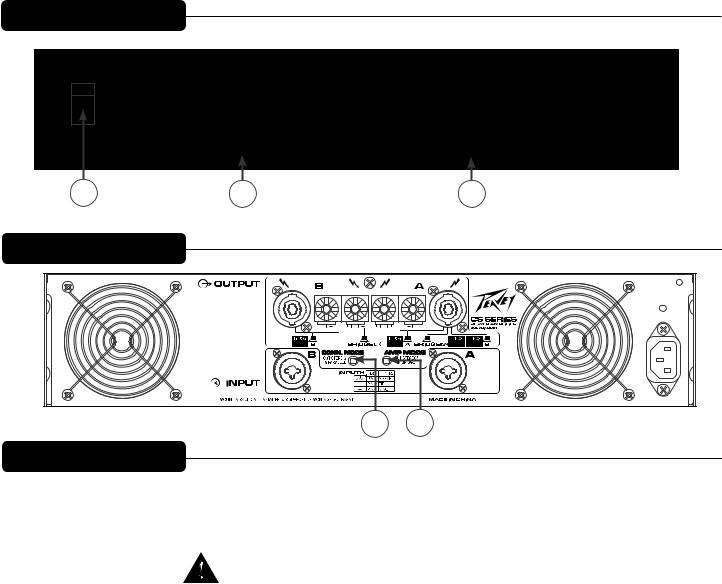
'SPOU 1BOFM
|
|
|
3FBS 1BOFM
4XJUDIFT $POUSPMT
"$ 1PXFS 4XJUDI $JSDVJU #SFBLFS
5IF $4 4FSJFT BNQMJGJFST GFBUVSF B DPNCJOBUJPO "$ TXJUDI DJSDVJU CSFBLFS PO UIF GSPOU QBOFM *G UIF TXJUDI TIVUT PGG EVSJOH OPSNBM VTF QVTI JU CBDL UP UIF 0/ QPTJUJPO PODF *G UIF TXJUDI XJMM OPU TUBZ JO UIF 0/ QPTJUJPO UIF BNQMJGJFS
OFFET TFSWJDJOH
CAUTION: The on/off switch in this unit does not break both sides of the primary mains.
Hazardous energy can be present inside the chassis when the on/off switch is in the off position.
*OQVU "UUFOVBUPST
8IFOFWFS QPTTJCMF TFU UIF BUUFOVBUPST GVMMZ DMPDLXJTF UP NBJOUBJO PQUJNVN TZTUFN IFBESPPN 5IF JOQVU BUUFOVBUPS DPOUSPMT POF GPS DIBOOFM " POF GPS DIBOOFM # MPDBUFE PO UIF GSPOU QBOFM BUUFOVBUF TJHOBM MFWFM EFDSFBTF HBJO GPS UIF SFTQFDUJWF BNQMJGJFS DIBOOFMT JO BMM NPEFT 4FF UIF TQFDJGJDBUJPOT BU UIF FOE PG UIJT NBOVBM GPS TUBOEBSE WPMUBHF HBJO BOE JOQVU TFOTJUJWJUZ JOGPSNBUJPO
$0// .0%& 4FMFDU 4XJUDI
%FQSFTTJOH UIF SFBS QBOFM $0// .0%& TFMFDU TXJUDI DPOOFDUT CPUI JOQVU DPOOFDUPST UPHFUIFS JO QBSBMMFM 5IJT EJSFDUT UIF TBNF JOQVU TJHOBM UP CPUI DIBOOFMT BOE BMMPXT POF DPOOFDUPS UP CF VTFE XJUI B QBUDI DBCMF UP ESJWF BOPUIFS BNQMJGJFS 8IFO JO UIF PVU QPTJUJPO CPUI JOQVU DPOOFDUPST PQFSBUF JOEFQFOEFOUMZ %P OPU PQFSBUF UIF $0// .0%& TFMFDU TXJUDI XJUI UIF BNQMJGJFS QPXFSFE PO 4FF UIF TFDUJPOT PO 4UFSFP 1BSBMMFM BOE #SJEHFE .POP NPEF GPS NPSF JOGPSNBUJPO
".1 .0%& 4FMFDU 4XJUDI
5IF SFBS QBOFM ".1 .0%& TFMFDU TXJUDI EFUFSNJOFT JG UIF BNQMJGJFS JT JO 4UFSFP UXP DIBOOFMT PS JO #SJEHFE .POP NPEF %P OPU PQFSBUF UIF ".1 .0%& TFMFDU TXJUDI XJUI UIF BNQMJGJFS QPXFSFE PO 4FF UIF 0QFSBUJPOT .PEF TFDUJPO GPS NPSF JOGPSNBUJPO PO 4UFSFP 1BSBMMFM BOE #SJEHFE .POP NPEF BQQMJDBUJPOT
11
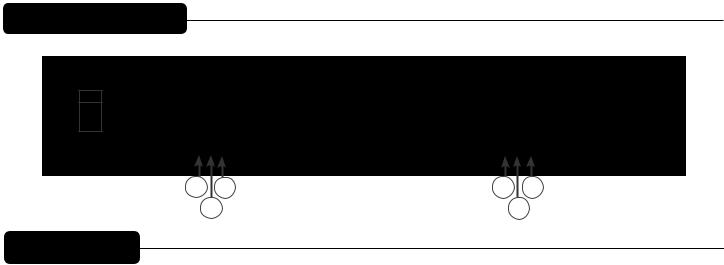
Front Panel
3 |
1 |
1 |
3 |
|
2 |
|
2 |
Indicators
CS® Series amplifiers feature three front panel LED indicators per channel: PWR (power), SIG (signal) and DDT™ (Distortion Detection Technique). These LED indicators inform the user of each channel’s operating status and warn of possible abnormal conditions.
PWR LED (1)
The Power LED indicates that the channel is operational. It illuminates under normal operation and remains on even when the channel’s DDT circuit is activated.
SIG LED (2)
The Signal LED illuminates when its channel produces an output signal of greater than 1 volt RMS or 25 mV input with a 0 dB attenuation of the front panel knobs. This is useful in determining whether a signal is reaching and being amplified by the amplifier. If the Signal LED is illuminated but no sound is present, that means a signal is present at the amplifier but a problem may exist after the amplifier, such as in the cables or speakers.
DDT LED (3)
A channel’s DDT LED will illuminate at the onset of clipping. If the LEDs are flashing quickly and intermittently, the channel is just at the clip threshold, while a steady, bright glow means the amp is clip limiting, or reducing gain to prevent severely clipped waveforms from reaching the speakers. See Distortion Detection Technique Limiting under the Protection Features section for more information.
12

Protection Features
The Peavey CS® Series incorporates several circuits to protect the amplifier and speakers under virtually any situation. Peavey has made the amplifiers as foolproof as possible by making them immune to short and open circuits, mismatched loads,
DC voltage and overheating. If a channel goes into the DDT™ gain reduction mode, the DDT LED illuminates. The clipping percentage or output power is instantly reduced. When a problem occurs that causes a channel to go into a protection mode, the PWR (Power) LED for that channel will turn off. DC voltage on the output or excessive subsonic frequencies will cause the speaker protection relay for that channel to open, protecting the speakers. If an amplifier channel overheats, the relay for that channel will open, disconnecting the load until the channel cools down, thus protecting the amplifier.
Distortion Detection Technique Limiting
Any time a channel is driven into hard, continuous clipping, the DDT circuit will automatically reduce the channel gain to a level just slightly into clipping, guarding the speakers against the damaging, high-power, continuous square waves that may be produced. Situations that may activate the DDT circuit include uncontrolled feedback, oscillations, an improper equipment setting or malfunction upstream from the amplifier. Normal program transients will not trigger DDT; only steady, excessive clipping will cause the DDT LED to illuminate.
LFC Impedance Sensing
CS Series amplifiers feature innovative circuitry for safe operation into any load. When an amplifier senses a load that overstresses the output stage, the Load Fault Correction circuit adjusts the channel gain to a safe level. Extreme load fault under high power levels will cause the speaker relay to disconnect the load for the associated channel. This method of output stage protection is far more effective than the standard limiting found on conventional power amplifiers. The LFC circuit is sonically transparent in normal use and unobtrusive when activated.
Thermal Protection
The internal fans will keep the amplifier operating well within its intended temperature range under all normal conditions. If a channel’s heat sink temperature reaches 85°C (which may indicate an obstructed air supply), that channel will independently protect itself by opening the speaker relay to disconnect the load until it has cooled. During this time, the PWR LED will go out and the cooling fans will continue operating at high speed.
Short Circuit
If an output is shorted, the LFC and thermal circuits will automatically protect the amplifier. The LFC circuit senses the short circuit as an extremely stressful load condition and attenuates the signal, protecting the channel’s output transistors from over-current stress. If the short circuit remains, the channel may eventually thermally protect itself by opening the speaker relay thereby disconnecting the load.
DC Voltage Protection
If an amplifier channel detects DC voltage or subsonic frequencies at its output terminals, the speaker protection relay for that channel will open, protecting the speakers.
Turn-On/Turn-Off Protection
Upon powering up, the amplifier mutes the input signals and stays in Protect mode with the speaker connect relays open for approximately four seconds. This allows the internal power supplies to charge and the amplifier to stabilize. After the relays engage, the signals slowly increase from muted to their normal level. Also, when power is removed, the input signals are muted so that no thumps or pops are heard.
13

Protection Features
RampUp™ Signal Control
Whenever a CS® Series amplifier powers up or comes out of a protect mode, the RampUp circuit activates. While the speakers are disconnected, the RampUp circuit fully attenuates the signal and activates the DDT™ LED. After the output relay closes, the signal slowly and gradually raises up to its set level. The PWR LED will illuminate and the DDT LED will turn off when the signal is no longer attenuated. The RampUp Signal Control circuit has some important advantages over the conventional instant-on circuits:
1.If a signal is present during power-up (or when coming out of protect), the speakers are spared a sudden, potentially damaging burst of audio power.
2.Because the gain is reduced until after the output relay closes, no arcing occurs at the contacts, thereby extending their useful life.
Speaker Protection
All loudspeakers have electrical, thermal and physical limits that must be observed to prevent damage or failure. Excessive power, low frequencies applied to high frequency drivers, severely clipped waveforms, and DC voltage can all be fatal to cone and compression drivers. Peavey CS Series amplifiers automatically protect speakers from DC voltages and subsonic signals. If using an electronic crossover, be extremely careful that the low and mid bands are connected to the correct amplifiers and drivers and not to those designed for a higher frequency band. An amplifier’s clipping point is its maximum peak output power, and some of the higher powered Peavey CS Series amplifiers can deliver more power than many speakers can safely handle. Be sure the peak power capability of the amplifier is not excessive for your speaker system. For more information, see the section on Protection Features.
Fuses may also be used to limit power to speaker drivers, although as current-limiting rather than voltage-limiting devices, they are an imperfect solution, and as the weakest links, they only limit once before needing replacement. Some poor-quality fuses have a significant series resistance that could degrade the amplifier’s damping of the speaker’s motion and may even deteriorate the system’s sound quality. If you elect to use fuses, check with the speaker manufacturer to determine the proper current rating and time lag required.
Do not drive any low frequency speaker enclosure with frequencies lower than its own tuned frequency; the reduced acoustical damping could cause a ported speaker to bottom out even at moderate power. Consult the speaker system specifications to determine its frequency limits.
14

Amplifier Maintenance and User Responsibility
A CS Series amplifier requires no routine maintenance and should not need internal adjustment during its lifetime. Your CS Series amplifier is very powerful and can be potentially dangerous to loudspeakers and humans alike. It is your responsibility to read the Important Precautions section and to make sure that the amplifier is installed, wired and operated properly as instructed in this manual. Many loudspeakers can be easily damaged or destroyed by overpowering, especially with the high power available from a bridged amplifier. Read the Speaker Protection section and always be aware of the speaker’s continuous and peak power capabilities.
Service / Warranty Information
In the unlikely event that your amplifier develops a problem, it must be returned to an authorized distributor, service center or shipped directly to our factory. To obtain service, contact your nearest Peavey Service Center, Distributor, Dealer, or any of the worldwide Peavey offices. For contact information, reach Peavey Inc. Customer Service directly:
Telephone: 601-483-5365 (USA)
Fax Number: 601-486-1278 (USA)
For technical inquiries only, the Peavey Technical Services department can be faxed at 601-486-1361 (USA)
Because of the complexity of the design and risk of electrical shock, all repairs must be performed only by qualified technical personnel. If the unit needs to be shipped back to the factory, it must be sent in its original carton. It is the responsibility of the person shipping the unit to properly package the amplifier. If you need a product shipping carton, please contact Peavey for a replacement.
Please visit the Peavey website at: http://www.peavey.com.
15
CS® Series 3000/4000/4080 HZ
Power Amplifiers
SPECIFICATIONS
CS 3000 |
CS 4000 |
CS 4080 HZ |
Rated Power Bridged Rated Power 2 x 2 ohms
Rated Power 2 x 4 ohms
Rated Power 2 x 8 ohms
Rated Power 1 x 2 ohms Rated Power 1 x 4 ohms Rated Power 1 x 8 ohms Minimum Load Impedance Maximum RMS Voltage Swing Frequency Response
Power Bandwidth
T.H.D. 2 x 2 ohms
T.H.D. 2 x 4 ohms
T.H.D. 2 x 8 ohms
Input CMRR
Voltage Gain
Crosstalk
Hum and Noise
3,050 watts @ 1 kHz at <0.1% T.H.D. @ 4 ohms
1,500 watts per channel @ 1 kHz <0.05% T.H.D. both channels driven
1,025 watts per channel @ 1 kHz at <0.05% T.H.D. both channels driven
650 watts per channel @
1 kHz at <0.05% T.H.D. both channels driven
2,000 watts @ 1 kHz at <0.1% T.H.D.
1,275 watts @ 1 kHz at <0.05% T.H.D.
750 watts @ 1 kHz at <0.05% T.H.D.
2 ohms
86 volts
10 Hz - 100 kHz; +0, -1.5 dB at 1 watt
10 Hz - 35 kHz; +0, -3 dB at rated 4 ohms power
<0.2% @ 1,200 watts per channel from 20 Hz to
20 kHz
<0.1% @ 925 watts per channel from 20 Hz to 20 kHz
<0.1% @ 600 watts per channel from 20 Hz to 20 kHz
> - 55 dB @ 1 kHz
x 40 (32 dB)
4,000 watts @ 1 kHz at <0.1% T.H.D. @ 4 ohms
2,000 watts per channel @ 1 kHz <0.1% T.H.D. both channels driven
1,350 watts per channel @ 1 kHz at <0.05% T.H.D. both channels driven
800 watts per channel @
1 kHz at <0.05% T.H.D. both channels driven
2,550 watts @ 1 kHz at <0.1% T.H.D.
1,600 watts @ 1 kHz at <0.05% T.H.D.
900 watts @ 1 kHz at <0.05% T.H.D.
2 ohms
93 volts
10 Hz - 100 kHz; +0, -2 dB at 1 watt
10 Hz - 35 kHz; +0, -3 dB at rated 4 ohms power
<0.2% @ 1,500 watts per channel from 20 Hz to 20 kHz
<0.1% @ 1,150 watts per channel from 20 Hz to 20 kHz
<0.1% @ 750 watts per channel from 20 Hz to 20 kHz
>- 75 dB @ 1 kHz x 40 (32 dB)
4,080 watts @ 1 kHz at <0.1% T.H.D. @ 8 ohms
N/A
2,040 watts per channel @ 1 kHz at <0.05% T.H.D. both channels driven
1,250 watts per channel
@ 1 kHz at <0.05% T.H.D. both channels driven
N/A
2,450 watts @ 1 kHz at <0.05% T.H.D.
1,400 watts @ 1 kHz at <0.05% T.H.D.
4 ohms
115 volts
10 Hz - 100 kHz; +0, -0.75 dB at 1 watt
10 Hz - 35 kHz; +0, -3 dB at rated 4 ohms power
N/A
<0.1% @ 1,650 watts per channel from 20 Hz to 20 kHz
<0.1% @ 950 watts per channel from 20 Hz to 20 kHz
> - 75 dB @ 1 kHz
x 40 (32 dB)
> -55 dB @ 1 kHz at |
> -70 dB @ 1 kHz at |
> -70 dB @ 1 kHz at |
rated power @ 8 ohms |
rated power @ 8 ohms |
rated power @ 8 ohms |
> -109 dB, “A” weighted |
> -108 dB, “A” weighted |
> -108 dB, “A” weighted |
referenced to rated power |
referenced to rated power |
referenced to rated power |
@ 8 ohms |
@ 8 ohms |
@ 8 ohms |
16
